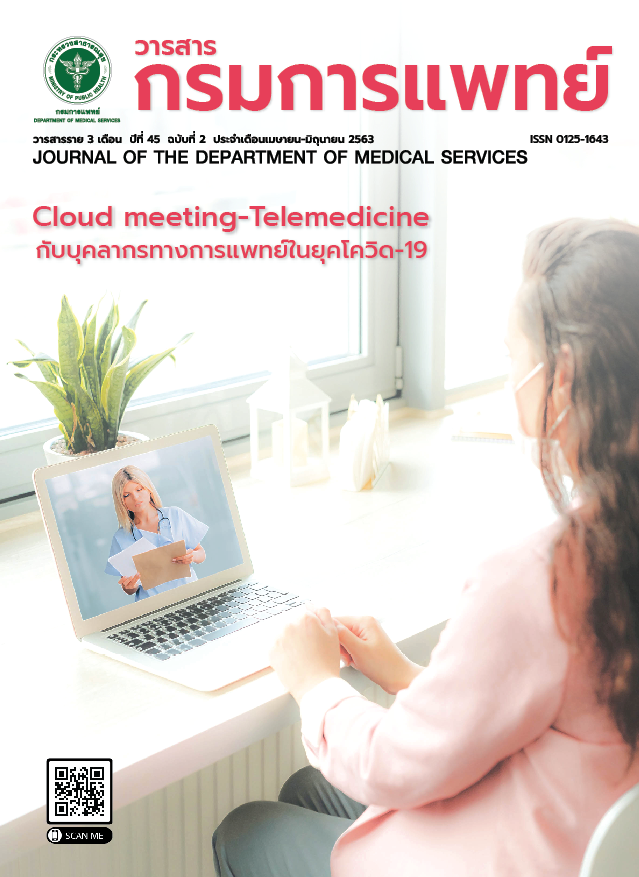Survey of Medical Facilities in Epilepsy Care in Thailand
Keywords:
Epilepsy care, secondary hospital, ThailandAbstract
Background: Epilepsy is common neurological disorder. Most epileptic patients could have seizure remission if appropriate epilepsy treatments are accessible. However, in Thailand, medical facilities in epilepsy care have not been provided adequately in all over regions. 58% of these patients, especially in rural regions, could not get proper medical care. Therefore, to improve treatment gap problem, basic medical facilities in epilepsy care need to be evaluated.
Objectives: To survey the medical resources in epilepsy care in secondary hospitals in Thailand.
Methods: Data were collected from all secondary hospitals (center hospital(A), general hospital(S) in 12 public health service areas by postal questionnaire survey during August 1-November 1,2018
Results: 36 out of 83 secondary hospital postal questionnaires were sent back (43.37%). This survey revealed epilepsy as nearly one fourth of neurological diseases presenting in both outpatient and inpatient units. 80.6 % of these hospitals had at least one medical personnel who was specialized in epilepsy. Internists are the main key persons taking care of this group of patients. Advanced investigations such as CT, MRI brain and EEG were available 97.2%, 34.3% and 40% respectively. 88.6% of the hospitals had all 4 types of standard oral antiepileptic drugs and all hospitals had at least one type of new antiepileptic drugs. The first and second most ones were lamotrigine and oxcarbazepine. Drug resistant epilepsy was concerned as problematic condition in most physicians (82.4%) but only 54.5% of them had experiences referring patient for epilepsy surgery.
Conclusions: Epilepsy treatment gap has still been important health care problem, especially in difficult to treat epileptic patients commonly seen in secondary hospitals. Further medical care resources in epilepsy need to be ascertained for more accurate information.
References
Trinka E, Kwan P, Lee B, Dash A. Epilepsy in Asia: disease burden, management barrier, and challenges. Epilepsia 2019; 60:7-2.
Jovel CE, Nagel AG, Serrano AA, Morales IG, Nagel AG.Epidermiological profile of epilepsy in low income populations. Seizure 2018; 56:67-72.
Meinardi H, Scott RA, Reis R, Sander JW. The treatment gap in epilepsy: the current situation and the way forward. Epilepsia 2001; 42:136-49.
A s a w a v i c h i e n j i n d a T , S a t t h i - A m o r n C , Ta n y a n o n t W .Prevalence of epilepsy in rural Thailand:a population-based study. J Med Assoc Thai 2002;85:1066-73.
Department of medical service, Ministry of public health. Thailand Medical Service Profile 2015-18.
Towanabut S. Survey of medical facilities for epileptic patients in Thailand 2012.
Phabphal K, Greater A, Limapichart K, Satirapunya P, Setthawatcharawanich S. Quality of life in epileptic patients in Southern Thailand. J Med Assoc Thai 2009;92:762-9.
Center of excellence in epilepsy, Prasat Neurological Institute. Planning project 2017-21: Better accessible medical care for epileptic patients in Thailand.
Kwan P, Brodie MJ. Early identification of refractory epilepsy. N Eng J Med 2000; 342:314-9.
Meyer AC, Dua T, Ma J, Saxena S, Birbeck G. Global disparities in the epilepsy treatment gap: a systemic review. Bulletin of the World Health Organization 2010;88:260-6.
Mbuba CK, Ngugi AK, Newton CR, Carter JA. The epilepsy treatment gap in developing countries: a systemic review of the magnitude, causes and intervention strategies.Epilepsia.2008 September; 49:1491-503.
Tiamkao S, Towanabut S, Dhiravibulyn K, Pranboon S, Sawanyawisuth K. Is the Thailand epilepsy service adequate to help patients? Neurology Asia 2013; 18:271-7.
Pranboon S, Lertsinudom S, Tiamkao S. Facility of epilepsy service in I San. North East Thai J neurosci 2011; 6:19-27.
NICE guideline: Epilepsy care. February 2013(online). available:http://www.nice.org.uk
Strategy and Planning division, Ministry of Public health. Report on public health resources concerning the public health in the year; 2016.
Tiamkao S, Pranboon S. National Health Security Office Region 7. Antiepileptic drugs available in 4 provinces of I-san. I-San j Intern Med 2011;10:28-35.
Lertsinudom S, Chainirun N, Tiamkao S.Facilities and Services for people with epilepsy-A survey from Northest Thailand. J Med Asso Thai 2017;100:S252-8.
Downloads
Published
How to Cite
Issue
Section
License
บทความที่ได้รับการตีพิมพ์เป็นลิขสิทธิ์ของกรมการแพทย์ กระทรวงสาธารณสุข
ข้อความและข้อคิดเห็นต่างๆ เป็นของผู้เขียนบทความ ไม่ใช่ความเห็นของกองบรรณาธิการหรือของวารสารกรมการแพทย์



